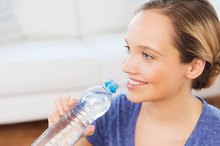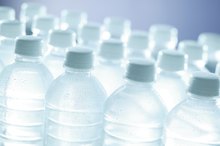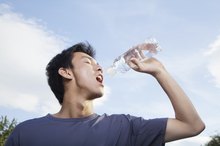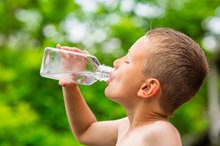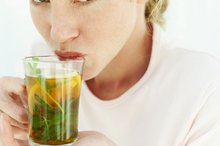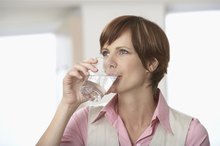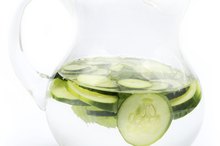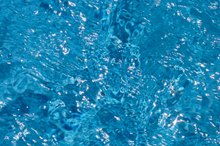USDA Recommended Daily Water Intake
The U.S. Department of Agriculture recommends different amounts of water based on age, sex and health status 1. The specific recommendations are based on the amount of water lost on a daily basis through perspiration, respiration, urination or metabolism. The USDA began setting dietary recommendations for water to help individuals avoid dehydration. The USDA recommendation is higher for those who live in hot, humid climates and for those who engage in prolonged exercise.
USDA Recommendation
People need from under one liter a day to nearly four liters a day depending on their age, sex and health status. One liter equals 4.23 cups. Newborns and infants need 0.7 to 0.8 liters of water a day from breast milk or formula. Toddlers need 1.3 liters and young children up to eight years need 1.7 liters daily. Boys, ages nine to 13 need 2.4 liters daily. Teenage boys and adult men need 2.7 liters. Girls, ages nine to 13 need 2.1 liters and teenage girls need 2.3 liters. Adult women need at least 2.7 liters of water each day. Women need at least 3 liters of water during pregnancy and 3.8 liters daily for lactation.
- People need from under one liter a day to nearly four liters a day depending on their age, sex and health status.
- Toddlers need 1.3 liters and young children up to eight years need 1.7 liters daily.
Basis for Recommendations
How Much Water Should Adolescents Consume?
Learn More
Up to 80 percent of your body weight is water. Muscle tissue is comprised of mostly water and protein. Your body also needs water to help digestion, to stay cool, repair or regenerate cells, keep blood pumping through your veins and to help flush toxins out of your body. Your body uses different amounts of water for these activities everyday, and much more in hot, humid weather or during exercise.
- Up to 80 percent of your body weight is water.
- Your body uses different amounts of water for these activities everyday, and much more in hot, humid weather or during exercise.
Meeting the Recommendation
People consume 80 percent of their daily water in beverages, and 20 percent of their daily water in foods, according to the USDA. The USDA does not place the value of any one single source of liquid water above another. You can get clean and safe mineral-rich water straight from your tap, or purchase bottled water.
Water is also present in just about every food that we eat. Water-bearing fruits such as apples, oranges, and melons are good dietary sources of water and can help you get you fulfill your daily water needs. Each serving of fruit contains one-half cup of water.
- People consume 80 percent of their daily water in beverages, and 20 percent of their daily water in foods, according to the USDA.
- You can get clean and safe mineral-rich water straight from your tap, or purchase bottled water.
Water is also present in just about every food that we eat.
History
Nutrition Facts of Dasani Water
Learn More
The USDA sets the Dietary Reference Intakes and updates them every few years 12. These guidelines set the standard for a healthy diet for healthy children and adults, and provide a frame of reference for state and federal nutrition assistance programs. The recommendations are based on a comprehensive meta-analysis by the National Academy of Science researchers of available peer-reviewed literature on water needs.
Related Articles
References
- National Academy of Sciences: Dietary Reference Intakes for Water
- Daniels MC, Popkin BM. “Impact of water intake on energy intake and weight status: a systematic review.” Nutr Rev. 2010 Sep;68(9):505-21.
- Dehydration. US National Institutes of Health Medline Public Information Sheet.
- Dietary Reference Intakes for Water, Potassium, Sodium, Chloride, and Sulfate Panel on Dietary Reference Intakes for Electrolytes and Water, Standing Committee on the Scientific Evaluation of Dietary Reference Intakes. National Academies Press. 2005.
- Friedrich Manz, MD “Hydration, and Disease.” J Am Coll Nutr October 2007 vol. 26 no. suppl 5.
- Hyponatremia. US National Institutes of Health Public Information sheet.
- Margaret McCartney. “Waterlogged?” BMJ 2011;343:d4280.
- Negoianu, Dan, and Goldfarb, Stanley. “Just Add Water.” Journal of the American Society of Nephrology: JASN, ISSN 1046-6673, 06/2008, Volume 19, Issue 6, pp. 1041 – 1043.
- Spero Tsindos. “What Drove Us to Drink 2 Litres of Water a Day?” Australian and New Zealand Journal of Public Health. Volume 36, Issue 3, pages 205–207, June 2012.
Writer Bio
Janelle Commins started writing professionally in 2007. She has written for the "UCLA Total Wellness" magazine on nutrition and fitness topics that are of interest to young adults. Her work has also appeared in various online publications. She holds a Bachelor of Science in nutrition science from University of California, Davis, and a Master of Science in public health from University of California, Los Angeles.
